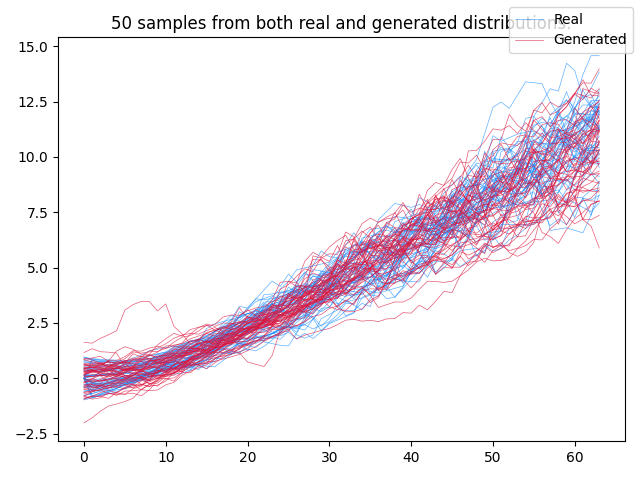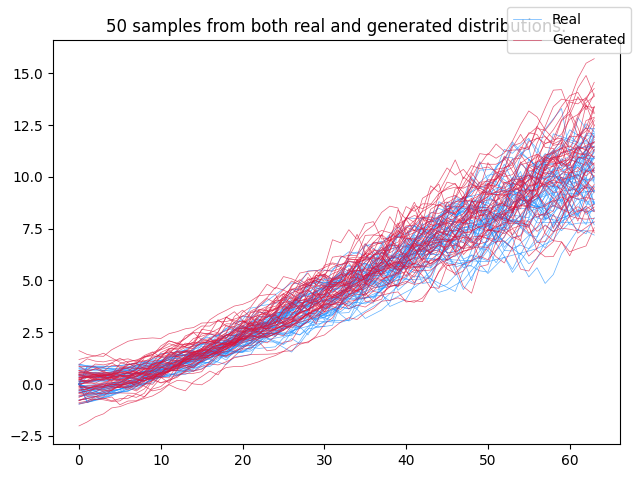Neural SDE¤
This example constructs a neural SDE as a generative time series model.
An SDE is, of course, random: it defines some distribution. Each sample is a whole path. Thus in modern machine learning parlance, an SDE is a generative time series model. This means it can be trained as a GAN, for example. This does mean we need a discriminator that consumes a path as an input; we use a CDE.
Training an SDE as a GAN is precisely what this example does. Doing so will reproduce the following toy example, which is trained on irregularly-sampled time series:

References:
Training SDEs as GANs:
@inproceedings{kidger2021sde1,
title={{N}eural {SDE}s as {I}nfinite-{D}imensional {GAN}s},
author={Kidger, Patrick and Foster, James and Li, Xuechen and Lyons, Terry J},
booktitle = {Proceedings of the 38th International Conference on Machine Learning},
pages = {5453--5463},
year = {2021},
volume = {139},
series = {Proceedings of Machine Learning Research},
publisher = {PMLR},
}
Improved training techniques:
@incollection{kidger2021sde2,
title={{E}fficient and {A}ccurate {G}radients for {N}eural {SDE}s},
author={Kidger, Patrick and Foster, James and Li, Xuechen and Lyons, Terry},
booktitle = {Advances in Neural Information Processing Systems 34},
year = {2021},
publisher = {Curran Associates, Inc.},
}
This example is available as a Jupyter notebook here.
Warning
This example will need a GPU to run efficiently.
Advanced example
This is an advanced example, due to the complexity of the modelling techniques used.
import diffrax
import equinox as eqx # https://github.com/patrick-kidger/equinox
import jax
import jax.nn as jnn
import jax.numpy as jnp
import jax.random as jr
import matplotlib.pyplot as plt
import optax # https://github.com/deepmind/optax
LipSwish activation functions are a good choice for the discriminator of an SDE-GAN. (Their use here was introduced in the second reference above.) For simplicity we will actually use LipSwish activations everywhere, even in the generator.
def lipswish(x):
return 0.909 * jnn.silu(x)
Now set up the vector fields appearing on the right hand side of each differential equation.
class VectorField(eqx.Module):
scale: int | jnp.ndarray
mlp: eqx.nn.MLP
def __init__(self, hidden_size, width_size, depth, scale, *, key, **kwargs):
super().__init__(**kwargs)
scale_key, mlp_key = jr.split(key)
if scale:
self.scale = jr.uniform(scale_key, (hidden_size,), minval=0.9, maxval=1.1)
else:
self.scale = 1
self.mlp = eqx.nn.MLP(
in_size=hidden_size + 1,
out_size=hidden_size,
width_size=width_size,
depth=depth,
activation=lipswish,
final_activation=jnn.tanh,
key=mlp_key,
)
def __call__(self, t, y, args):
t = jnp.asarray(t)
return self.scale * self.mlp(jnp.concatenate([t[None], y]))
class ControlledVectorField(eqx.Module):
scale: int | jnp.ndarray
mlp: eqx.nn.MLP
control_size: int
hidden_size: int
def __init__(
self, control_size, hidden_size, width_size, depth, scale, *, key, **kwargs
):
super().__init__(**kwargs)
scale_key, mlp_key = jr.split(key)
if scale:
self.scale = jr.uniform(
scale_key, (hidden_size, control_size), minval=0.9, maxval=1.1
)
else:
self.scale = 1
self.mlp = eqx.nn.MLP(
in_size=hidden_size + 1,
out_size=hidden_size * control_size,
width_size=width_size,
depth=depth,
activation=lipswish,
final_activation=jnn.tanh,
key=mlp_key,
)
self.control_size = control_size
self.hidden_size = hidden_size
def __call__(self, t, y, args):
t = jnp.asarray(t)
return self.scale * self.mlp(jnp.concatenate([t[None], y])).reshape(
self.hidden_size, self.control_size
)
Now set up the neural SDE (the generator) and the neural CDE (the discriminator).
-
Note the use of very large step sizes. By using a large step size we essentially "bake in" the discretisation. This is quite a standard thing to do to decrease computational costs, when the vector field is a pure neural network. (You can reduce the step size here if you want to -- which will increase the computational cost, of course.)
-
Note the
clip_weightsmethod on the CDE -- this is part of imposing the Lipschitz condition on the discriminator of a Wasserstein GAN. (The other thing doing this is the use of those LipSwish activation functions we saw earlier)
class NeuralSDE(eqx.Module):
initial: eqx.nn.MLP
vf: VectorField # drift
cvf: ControlledVectorField # diffusion
readout: eqx.nn.Linear
initial_noise_size: int
noise_size: int
def __init__(
self,
data_size,
initial_noise_size,
noise_size,
hidden_size,
width_size,
depth,
*,
key,
**kwargs,
):
super().__init__(**kwargs)
initial_key, vf_key, cvf_key, readout_key = jr.split(key, 4)
self.initial = eqx.nn.MLP(
initial_noise_size, hidden_size, width_size, depth, key=initial_key
)
self.vf = VectorField(hidden_size, width_size, depth, scale=True, key=vf_key)
self.cvf = ControlledVectorField(
noise_size, hidden_size, width_size, depth, scale=True, key=cvf_key
)
self.readout = eqx.nn.Linear(hidden_size, data_size, key=readout_key)
self.initial_noise_size = initial_noise_size
self.noise_size = noise_size
def __call__(self, ts, *, key):
t0 = ts[0]
t1 = ts[-1]
# Very large dt0 for computational speed
dt0 = 1.0
init_key, bm_key = jr.split(key, 2)
init = jr.normal(init_key, (self.initial_noise_size,))
control = diffrax.VirtualBrownianTree(
t0=t0, t1=t1, tol=dt0 / 2, shape=(self.noise_size,), key=bm_key
)
vf = diffrax.ODETerm(self.vf) # Drift term
cvf = diffrax.ControlTerm(self.cvf, control) # Diffusion term
terms = diffrax.MultiTerm(vf, cvf)
# ReversibleHeun is a cheap choice of SDE solver. We could also use Euler etc.
solver = diffrax.ReversibleHeun()
y0 = self.initial(init)
saveat = diffrax.SaveAt(ts=ts)
sol = diffrax.diffeqsolve(terms, solver, t0, t1, dt0, y0, saveat=saveat)
return jax.vmap(self.readout)(sol.ys)
class NeuralCDE(eqx.Module):
initial: eqx.nn.MLP
vf: VectorField
cvf: ControlledVectorField
readout: eqx.nn.Linear
def __init__(self, data_size, hidden_size, width_size, depth, *, key, **kwargs):
super().__init__(**kwargs)
initial_key, vf_key, cvf_key, readout_key = jr.split(key, 4)
self.initial = eqx.nn.MLP(
data_size + 1, hidden_size, width_size, depth, key=initial_key
)
self.vf = VectorField(hidden_size, width_size, depth, scale=False, key=vf_key)
self.cvf = ControlledVectorField(
data_size, hidden_size, width_size, depth, scale=False, key=cvf_key
)
self.readout = eqx.nn.Linear(hidden_size, 1, key=readout_key)
def __call__(self, ts, ys):
# Interpolate data into a continuous path.
ys = diffrax.linear_interpolation(
ts, ys, replace_nans_at_start=0.0, fill_forward_nans_at_end=True
)
init = jnp.concatenate([ts[0, None], ys[0]])
control = diffrax.LinearInterpolation(ts, ys)
vf = diffrax.ODETerm(self.vf)
cvf = diffrax.ControlTerm(self.cvf, control)
terms = diffrax.MultiTerm(vf, cvf)
solver = diffrax.ReversibleHeun()
t0 = ts[0]
t1 = ts[-1]
dt0 = 1.0
y0 = self.initial(init)
# Have the discriminator produce an output at both `t0` *and* `t1`.
# The output at `t0` has only seen the initial point of a sample. This gives
# additional supervision to the distribution learnt for the initial condition.
# The output at `t1` has seen the entire path of a sample. This is needed to
# actually learn the evolving trajectory.
saveat = diffrax.SaveAt(t0=True, t1=True)
sol = diffrax.diffeqsolve(terms, solver, t0, t1, dt0, y0, saveat=saveat)
return jax.vmap(self.readout)(sol.ys)
@eqx.filter_jit
def clip_weights(self):
leaves, treedef = jax.tree_util.tree_flatten(
self, is_leaf=lambda x: isinstance(x, eqx.nn.Linear)
)
new_leaves = []
for leaf in leaves:
if isinstance(leaf, eqx.nn.Linear):
lim = 1 / leaf.out_features
leaf = eqx.tree_at(
lambda x: x.weight, leaf, leaf.weight.clip(-lim, lim)
)
new_leaves.append(leaf)
return jax.tree_util.tree_unflatten(treedef, new_leaves)
Next, the dataset. This follows the trajectories you can see in the picture above. (Namely positive drift with mean-reversion and time-dependent diffusion.)
@jax.jit
@jax.vmap
def get_data(key):
bm_key, y0_key, drop_key = jr.split(key, 3)
mu = 0.02
theta = 0.1
sigma = 0.4
t0 = 0
t1 = 63
t_size = 64
def drift(t, y, args):
return mu * t - theta * y
def diffusion(t, y, args):
return jnp.array([2 * sigma * t / t1])
bm = diffrax.UnsafeBrownianPath(shape=(), key=bm_key)
drift = diffrax.ODETerm(drift)
diffusion = diffrax.ControlTerm(diffusion, bm)
terms = diffrax.MultiTerm(drift, diffusion)
solver = diffrax.Euler()
dt0 = 0.1
y0 = jr.uniform(y0_key, (1,), minval=-1, maxval=1)
ts = jnp.linspace(t0, t1, t_size)
saveat = diffrax.SaveAt(ts=ts)
sol = diffrax.diffeqsolve(
terms, solver, t0, t1, dt0, y0, saveat=saveat, adjoint=diffrax.DirectAdjoint()
)
# Make the data irregularly sampled
to_drop = jr.bernoulli(drop_key, 0.3, (t_size, 1))
ys = jnp.where(to_drop, jnp.nan, sol.ys)
return ts, ys
def dataloader(arrays, batch_size, loop, *, key):
dataset_size = arrays[0].shape[0]
assert all(array.shape[0] == dataset_size for array in arrays)
indices = jnp.arange(dataset_size)
while True:
perm = jr.permutation(key, indices)
key = jr.split(key, 1)[0]
start = 0
end = batch_size
while end < dataset_size:
batch_perm = perm[start:end]
yield tuple(array[batch_perm] for array in arrays)
start = end
end = start + batch_size
if not loop:
break
Now the usual training step for GAN training.
There is one neural-SDE-specific trick here: we increase the update size (i.e. the learning rate) for those parameters describing (and discriminating) the initial condition of the SDE. Otherwise the model tends to focus just on fitting just the rest of the data (i.e. the random evolution over time).
@eqx.filter_jit
def loss(generator, discriminator, ts_i, ys_i, key, step=0):
batch_size, _ = ts_i.shape
key = jr.fold_in(key, step)
key = jr.split(key, batch_size)
fake_ys_i = jax.vmap(generator)(ts_i, key=key)
real_score = jax.vmap(discriminator)(ts_i, ys_i)
fake_score = jax.vmap(discriminator)(ts_i, fake_ys_i)
return jnp.mean(real_score - fake_score)
@eqx.filter_grad
def grad_loss(g_d, ts_i, ys_i, key, step):
generator, discriminator = g_d
return loss(generator, discriminator, ts_i, ys_i, key, step)
def increase_update_initial(updates):
get_initial_leaves = lambda u: jax.tree_util.tree_leaves(u.initial)
return eqx.tree_at(get_initial_leaves, updates, replace_fn=lambda x: x * 10)
@eqx.filter_jit
def make_step(
generator,
discriminator,
g_opt_state,
d_opt_state,
g_optim,
d_optim,
ts_i,
ys_i,
key,
step,
):
g_grad, d_grad = grad_loss((generator, discriminator), ts_i, ys_i, key, step)
g_updates, g_opt_state = g_optim.update(g_grad, g_opt_state)
d_updates, d_opt_state = d_optim.update(d_grad, d_opt_state)
g_updates = increase_update_initial(g_updates)
d_updates = increase_update_initial(d_updates)
generator = eqx.apply_updates(generator, g_updates)
discriminator = eqx.apply_updates(discriminator, d_updates)
discriminator = discriminator.clip_weights()
return generator, discriminator, g_opt_state, d_opt_state
This is our main entry point. Try running main().
def main(
initial_noise_size=5,
noise_size=3,
hidden_size=16,
width_size=16,
depth=1,
generator_lr=2e-5,
discriminator_lr=1e-4,
batch_size=1024,
steps=10000,
steps_per_print=200,
dataset_size=8192,
seed=5678,
):
key = jr.PRNGKey(seed)
(
data_key,
generator_key,
discriminator_key,
dataloader_key,
train_key,
evaluate_key,
sample_key,
) = jr.split(key, 7)
data_key = jr.split(data_key, dataset_size)
ts, ys = get_data(data_key)
_, _, data_size = ys.shape
generator = NeuralSDE(
data_size,
initial_noise_size,
noise_size,
hidden_size,
width_size,
depth,
key=generator_key,
)
discriminator = NeuralCDE(
data_size, hidden_size, width_size, depth, key=discriminator_key
)
g_optim = optax.rmsprop(generator_lr)
d_optim = optax.rmsprop(-discriminator_lr)
g_opt_state = g_optim.init(eqx.filter(generator, eqx.is_inexact_array))
d_opt_state = d_optim.init(eqx.filter(discriminator, eqx.is_inexact_array))
infinite_dataloader = dataloader(
(ts, ys), batch_size, loop=True, key=dataloader_key
)
for step, (ts_i, ys_i) in zip(range(steps), infinite_dataloader):
step = jnp.asarray(step)
generator, discriminator, g_opt_state, d_opt_state = make_step(
generator,
discriminator,
g_opt_state,
d_opt_state,
g_optim,
d_optim,
ts_i,
ys_i,
key,
step,
)
if (step % steps_per_print) == 0 or step == steps - 1:
total_score = 0
num_batches = 0
for ts_i, ys_i in dataloader(
(ts, ys), batch_size, loop=False, key=evaluate_key
):
score = loss(generator, discriminator, ts_i, ys_i, sample_key)
total_score += score.item()
num_batches += 1
print(f"Step: {step}, Loss: {total_score / num_batches}")
# Plot samples
fig, ax = plt.subplots()
num_samples = min(50, dataset_size)
ts_to_plot = ts[:num_samples]
ys_to_plot = ys[:num_samples]
def _interp(ti, yi):
return diffrax.linear_interpolation(
ti, yi, replace_nans_at_start=0.0, fill_forward_nans_at_end=True
)
ys_to_plot = jax.vmap(_interp)(ts_to_plot, ys_to_plot)[..., 0]
ys_sampled = jax.vmap(generator)(ts_to_plot, key=jr.split(sample_key, num_samples))[
..., 0
]
kwargs = dict(label="Real")
for ti, yi in zip(ts_to_plot, ys_to_plot):
ax.plot(ti, yi, c="dodgerblue", linewidth=0.5, alpha=0.7, **kwargs)
kwargs = {}
kwargs = dict(label="Generated")
for ti, yi in zip(ts_to_plot, ys_sampled):
ax.plot(ti, yi, c="crimson", linewidth=0.5, alpha=0.7, **kwargs)
kwargs = {}
ax.set_title(f"{num_samples} samples from both real and generated distributions.")
fig.legend()
fig.tight_layout()
fig.savefig("neural_sde.png")
plt.show()
main()
Step: 0, Loss: 0.13390611750738962
Step: 200, Loss: 4.786926678248814
Step: 400, Loss: 7.736175605228969
Step: 600, Loss: 10.103722981044225
Step: 800, Loss: 11.831081799098424
Step: 1000, Loss: 7.418417045048305
Step: 1200, Loss: 6.938951356070382
Step: 1400, Loss: 2.881302390779768
Step: 1600, Loss: 1.5363099915640694
Step: 1800, Loss: 1.0079529796327864
Step: 2000, Loss: 0.936917781829834
Step: 2200, Loss: 0.9594544768333435
Step: 2400, Loss: 1.247592806816101
Step: 2600, Loss: 0.9021680951118469
Step: 2800, Loss: 0.861811808177403
Step: 3000, Loss: 1.1381437267575945
Step: 3200, Loss: 1.5369644505637032
Step: 3400, Loss: 1.3387839964457922
Step: 3600, Loss: 1.0477747491427831
Step: 3800, Loss: 1.7565655538014002
Step: 4000, Loss: 1.8188678196498327
Step: 4200, Loss: 1.4719816957201277
Step: 4400, Loss: 1.4189972026007516
Step: 4600, Loss: 0.6867345826966422
Step: 4800, Loss: 0.6138326355389186
Step: 5000, Loss: 0.5908999613353184
Step: 5200, Loss: 0.579599814755576
Step: 5400, Loss: -0.8964726499148777
Step: 5600, Loss: -4.22784035546439
Step: 5800, Loss: 1.8623723132269723
Step: 6000, Loss: -0.17913252328123366
Step: 6200, Loss: 1.2232166869299752
Step: 6400, Loss: 1.1680303982325964
Step: 6600, Loss: -0.5765694592680249
Step: 6800, Loss: 0.5931433950151715
Step: 7000, Loss: 0.12497492773192269
Step: 7200, Loss: 0.5957097922052655
Step: 7400, Loss: 0.33551327671323505
Step: 7600, Loss: 0.5243289640971592
Step: 7800, Loss: 0.797236042363303
Step: 8000, Loss: 0.5341930559703282
Step: 8200, Loss: 1.1995042221886771
Step: 8400, Loss: -0.5231874521289553
Step: 8600, Loss: -0.42040516648973736
Step: 8800, Loss: 1.384656548500061
Step: 9000, Loss: 1.4223246574401855
Step: 9200, Loss: 0.2646511915538992
Step: 9400, Loss: -0.046253203813518794
Step: 9600, Loss: 0.738983656678881
Step: 9800, Loss: 1.1247712458883012
Step: 9999, Loss: -0.44179755449295044
